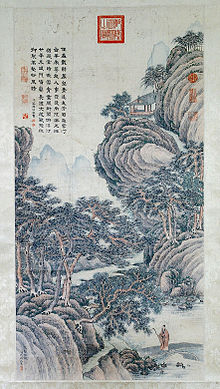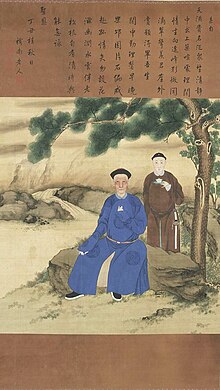|
Yunxi (prince)
Yunxi (允禧; 27 February 1711 – 26 June 1758) was Kangxi Emperor's 21st surviving son and the first Prince Shen of the Second Rank. Due to his age, Yunxi was not embroiled in the succession war among Kangxi Emperor's sons. Yunxi belonged to the most notable artists of the Qing dynasty.[1] LifeEarly yearsYunxi was born on 27 February 1711 to lady Chen, Noble Lady Qian (倩贵人).[2] Due to vast disproportion in the age of the representatives of his generation, he would normally belong to "hong" generation as he was born on the same year as Qianlong Emperor. In 1722, his mother was promoted to concubine Xi (熙嫔).[3]  Affiliation with artYunxi was one of the most excellent Kangxi Emperor's sons due to his talent for arts and diligence in studies. Most of Yunxi's paintings used Gongbi technique following the school of Dong Yuan and Wen Zhengming, one of the most renowned Ming dynasty artists.[4] Actually, Yunxi's artworks exceed from the definition of monochromy using great palette of colours, as shown on the painting "Wind in Ten Thousand Pine gully" ("万壑松风"). Therefore, Yunxi was considered the best painter of the Kangxi-Qianlong eras imperial court.[5] Yunxi was befriended with imperial court artists, such as Giuseppe Castiglione[6] and Zheng Xie.[7] Moreover, he associated himself with numerous taoist priests and buddhist monks[8] and pursued meditation. That relationship with monks was exposed on his paintings by the depiction of taoist monk in purple clothes.[9] Yunxi was also known to engage himself in poetry. Apart from writing poems on art works, Yunxi wrote a cycle of poems "Poetry from Huajian hall".[10] Political careerYunxi kept low profile during succession brawl among his brothers largely due to his young age (barely 11 years). In 1730, Yunxi was granted a title of Prince of the Fourth Rank.[11] He was promoted to Prince of the Third Rank on the same year.[12] In 1735, Qianlong Emperor gave him a title of Prince Shen of the Second Rank, appointed as a commander of Han Chinese Plain Yellow Banner forces and praised him in his decree:
Yunxi kept neutrality during Coup of Hongxi, despite one of his brothers was implicated in the case. He held an official position in the Ministry of Revenue[14] In 1748, Yunxi's princely seal was stolen and sold by merchant in Jiangxi. According to Mr. Mark Peter St. Nicholas, this accident was one of the numerous cases of forgery in Qing dynasty.[15] Yunxi died on 26 June 1758 and was posthumously honoured as Prince Shenjing of the Second Rank (多罗慎靖郡王, meaning "prudent and tranquil").[16] NamesCourtesy name
Art name
FamilyYunxi was married to lady Zugiya, daughter of fourth rank military official Jianqi (建器). His primary consort had undergone selection together with future Empress Xiaoxianchun, lady Fuca, Primary Princess Consort Hegong, lady Ujaku. Lady Zu was initially reluctant to marry him so the proper marriage was finally held in 1732, five years after the selection. Yunxi was succeeded by his adoptive grandson Yongrong as his sons died childless. After the adoption of Yongrong, the peerage was renamed to Prince Zhi of the Second Rank (质郡王) and later promoted to the first rank.[19] Primary Consort
Secondary Consort
References
|
||||||||||||||||||||||||||||||||||||
